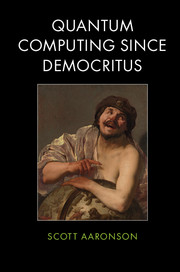Book contents
- Frontmatter
- Dedication
- Contents
- Preface
- Acknowledgments
- 1 Atoms and the void
- 2 Sets
- 3 Gödel, Turing, and friends
- 4 Minds and machines
- 5 Paleocomplexity
- 6 P, NP, and friends
- 7 Randomness
- 8 Crypto
- 9 Quantum
- 10 Quantum computing
- 11 Penrose
- 12 Decoherence and hidden variables
- 13 Proofs
- 14 How big are quantum states?
- 15 Skepticism of quantum computing
- 16 Learning
- 17 Interactive proofs, circuit lower bounds, and more
- 18 Fun with the Anthropic Principle1
- 19 Free will
- 20 Time travel
- 21 Cosmology and complexity
- 22 Ask me anything
- Index
13 - Proofs
Published online by Cambridge University Press: 05 April 2013
- Frontmatter
- Dedication
- Contents
- Preface
- Acknowledgments
- 1 Atoms and the void
- 2 Sets
- 3 Gödel, Turing, and friends
- 4 Minds and machines
- 5 Paleocomplexity
- 6 P, NP, and friends
- 7 Randomness
- 8 Crypto
- 9 Quantum
- 10 Quantum computing
- 11 Penrose
- 12 Decoherence and hidden variables
- 13 Proofs
- 14 How big are quantum states?
- 15 Skepticism of quantum computing
- 16 Learning
- 17 Interactive proofs, circuit lower bounds, and more
- 18 Fun with the Anthropic Principle1
- 19 Free will
- 20 Time travel
- 21 Cosmology and complexity
- 22 Ask me anything
- Index
Summary
We're going to start by beating a retreat from QuantumLand, back onto the safe territory of computational complexity. In particular, we're going to see how, in the 1980s and 1990s, computational complexity theory reinvented the millennia-old concept of mathematical proof – making it probabilistic, interactive, and cryptographic. But then, having fashioned our new pruning-hooks (proving-hooks?), we're going to return to QuantumLand and reap the harvest. In particular, I’ll show you why, if you could see the entire trajectory of a hidden variable, then you could efficiently solve any problem that admits a “statistical zero-knowledge proof protocol,” including problems like Graph Isomorphism for which no efficient quantum algorithm is yet known.
What is a proof?
Historically, mathematicians have had two very different notions of “proof.”
The first is that a proof is something that induces in the audience (or at least the prover!) an intuitive sense of certainty that the result is correct. In this view, a proof is an inner transformative experience – a way for your soul to make contact with the eternal verities of Platonic heaven.
- Type
- Chapter
- Information
- Quantum Computing since Democritus , pp. 186 - 199Publisher: Cambridge University PressPrint publication year: 2013

